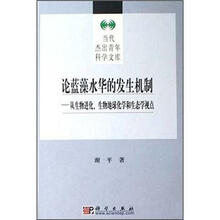论蓝藻水华的发生机制:从生物进化、生物地球化学和生态学视点

目录前言第一章 蓝藻概述 1一、蓝藻细胞的一般特征 2二、地球生命系统起源与蓝藻作为最古老的光合产氧者的证据 7三、蓝藻对地球生物圈形成的关键作用以及光系统的进化 14四、蓝藻的非释氧光合作用和异养生活能力 21五、蓝藻的光合色素 22六、结语 28第二章 人类活动、富营养化和藻类水华 30一、自然界中的水资源和氮、磷循环 30二、人类活动与富营养化 36三、沉积物记录富营养化历程 39四、富营养水体藻类水华频发 41五、结语 48第三章 蓝藻水华与N/P比学说 50一、影响蓝藻生长的因子及形成水华的蓝藻 50二、蓝藻的固氮作用 52三、N/P比学说 53四、武汉东湖的富营养化与蓝藻水华 55五、低N/P比是蓝藻水华发生的原因还是结果? 59六、浅水湖泊营养水平对内源P负荷的波动影响 71七、结语 75第四章 浮游植物对无机碳的利用及对pH的影响 76一、碳循环 76二、溶解性无机碳的形态 77三、长江流域水体中溶解性无机碳的优势形态 79四、浮游植物对无机碳的利用及对pH的影响 81五、浮游植物生物量/生产量与水体pH的相关关系 85六、结语 87第五章 沉积物中的磷及其释放 89一、水系统中的含磷化合物 89二、沉积物中磷的形态 92三、土壤/沉积物中磷的固定 95四、pH对沉积物中磷释放影响的早期实验或野外研究 96五、pH和氧化还原电位对沉积物的磷吸附与解吸的影响 102六、结语 104第六章 Fe-P、Ca-P和Al-P与沉积物中磷释放的关系 105一、沉积物中磷释放速率与磷形态的关系 105二、沉积物中Fe-P/Ca-P比与磷释放的关系 105三、影响沉积物中Fe-P/Ca-P比变化的因素 107四、富营养化对巢湖沉积物中Fe-P、Ca-P和Al-P含量的影响 108五、富营养化对长江中下游湖泊沉积物中Fe-P 、Ca-P 和Al-P含量的影响 109六、水中铁的形态及沉积物中铁与磷的结合比例 112七、结语 116第七章 蓝藻与水生高等植物 117一、蓝藻对水生高等植物的化感抑制作用 117二、水生高等植物对蓝藻的化感抑制作用 122三、水生植物对蓝藻的其他生态学影响 127四、浅水湖泊中浊水和清水稳态之间的转换 130五、结语 133第八章 鱼类与蓝藻水华 135一、蓝藻水华对自然水体中鱼类的影响 135二、蓝藻水华的控制措施 136三、鲢和鳙的自然分布与摄食特性 137四、在太湖梅梁湾进行的利用鲢、鳙控制蓝藻水华的实验研究 140五、为何鲢、鳙对有毒微囊藻水华抗性很强? 150六、结语 154第九章 蓝藻水华的成因 156一、食物网的复杂性与蓝藻水华的可预测性 156二、水温对蓝藻水华形成的影响 159三、蓝藻的光捕获特性及光能利用效率 161四、pH与蓝藻水华 164五、微量元素与蓝藻水华 168六、氮、磷与蓝藻水华 170七、蓝藻与竞争者和牧食者之间的相互关系 173八、结语 177主要参考文献 179ContentsPrefaceChapter 1 General introduction to cyanobacteria 11. General features of cyanobacterial cells 22. Origin of the life system on earth and evidences for cyanobac teria as the first oxygen producer 73. The key role of cyanobacteria in the formation of biosphere on earth and the evolution of photosynthetic systems 144. Anoxygenic photosynthesis and heterotrophic capability of cyanobacteria 215. Photosynthetic pigments of cyanobacteria 226. Concluding remarks 28Chapter 2 Human activities ,eutrophication and algal blooms 301. Water resource and natural cycles of N and P 302. Human activities and eutrophication 363. Sediments record history of eutrophication 394. Algal blooms frequently occur in eutrophic waters 415. Concluding remarks 48Chapter 3 Cyanobacterial blooms and N/P hypothesis 501. Factors influencing cyanobacterial growth and blooms 502. Nitrogen fixing by cyanobacteria 523. N/P hypothesis 534. Eutrophication and cyanobacterial blooms in Lake Donghu , Wuhan 555. The low TN : TP ratio , a cause or a result of Microcystis blooms? 596. Effects of trophic level on internal P loading in shallow lakes 717. Concluding remarks 75Chapter 4 Utilization of inorganic carbon by phytoplankton and the effects on pH 761. Carbon cycle 762. Species of dissolved inorganic carbon 773. Dominant species of dissolved inorganic carbon in waterbodies of the Yangtze River 794. Utilization of inorganic carbon by phytoplankton and the effects on pH 815. Correlation between biomass/production of phytoplankton and pH in water 856. Concluding remarks 87Chapter 5 Phosphorus in sediment and its release 891. Phosphorus compound in aquatic systems 892. Phosphorus species in sediment 923. Phosphorus fixing in soil/sediments 954. Early experimental or field studies on the effects of pH on phosphorus release from sediment 965. Effects of pH and redox potential on adsorption and desorption of phosphorus of the sediment 1026. Concluding remarks 104Chapter 6 The relation between Fe-P ,Ca-P and Al-P ,and phosphorus release from sediment 1051. The relation between species and release rate of phosphorus from sediment 1052. The relation between Fe-P/Ca-P ratio and phosphorus release rate from sediment 1053. Factors influencing the Fe-P/Ca-P ratio in sediment 1074. Effects of eutrophication on the contents of Fe-P ,Ca-P and Al-P in sediment in Lake Chaohu 1085. Effects of eutrophication on the contents of Fe-P ,Ca-P and Al-P in sediment in lakes in the middle and lower reaches of the Yangtze River 1096. Species of iron in water and the proportion of the iron-bound phosphorus in sediment 1127. Concluding remarks 116Chapter 7 The relation between cyanobacteria and macrophytes 1171. Growth inhibition of macrophytes by the allelopathic compounds of cyanobacteria 1172. Growth inhibition of cyanobacteria by the allelopathic compounds of macrophytes 1223. Other ecological effects on cyanobacteria by macrophytes 1274. Shift between turbid and clear stable states in shallow lakes 1305. Concluding remarks 133Chapter 8 The relation between fish and cyanobacteria 1351. Effects of cyanobacterial blooms on fish in natural waters 1352. Means of controlling cyanobacterial blooms 1363. Natural distribution of silver and bighead carps and their feeding habits 137
谢平,湖北洪湖人,中国科学院水生生物研究所研究员,华中农业大学水产学院讲座教授。1989年于日本筑波大学生物系获理学博士学位,1998年入选中国科学院“百人计划”,现任中国科学院生态系统研究网络东湖湖泊生态系统试验站(国家重点野外台站)站长,淡水生态与生物技术国家重点实验室副主任,中国科学院水生生物研究所淡水生态学研究中心主任,现主要从事淡水生态学和生态毒理学方面的研究。1999年获第9届日本琵琶湖生态学奖,2001年,获得中国科学院青年科学家奖(创新奖)并被评为优秀“百人计划”获得者,2003年获国家杰出青年基金资助。在国内外学术杂志上发表研究论文140多篇,其中SCI源刊论文100余篇。现担任Ecologic Research(SCI源刊)、Limnolog(SCI源刊)、Freshwatet System杂志(A domairl Of the Sciermfic World.Journal)(SCI源刊)的编委及《湖泊科学》副主编。
《论蓝藻水华的发生机制——从生物进化生物》是一部从生物进化、生物地球化学和生态学视点论述蓝藻水华发生机制的专著。《论蓝藻水华的发生机制——从生物进化生物》共分为几章,第一章主要是从地球进化的历史角度米分析蓝藻对地球生命系统的贡献;第二章简要说明人类活动的历史过程对水体富营养化和藻类水华发生的影响;第三章到第六章主要是从生源要素(特别是磷)的地球化学的角度分析同际上流行的用于解释蓝藻水华发生机制的N/P比学说,这里涉及植物的光合作用与pH之间的关系,沉积物中磷的形态与释放及其控制因子等;第七章分析水体中两个主要的初级生产者——蓝藻和水生高等植物之间的相生相克关系;第八章介绍鱼类与蓝藻水华的关系,重点介绍利用鲢、鳙控制有毒蓝藻水华的生理生态学研究;第九章综述蓝藻水华的成因。
比价列表
公众号、微信群
 缺书网
缺书网微信公众号
 扫码进群
扫码进群实时获取购书优惠







